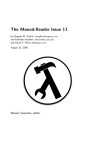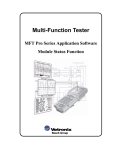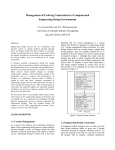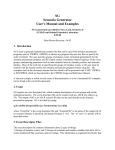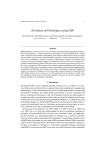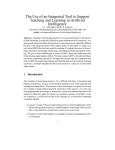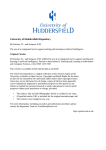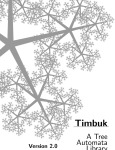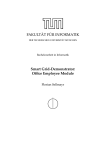Download as a PDF
Transcript
Capturing Quantified Constraints in FOL, through Interaction with a Relationship Graph Peter M.D. Gray1 and Graham J.L. Kemp2 1 2 Department of Computing Science, University of Aberdeen, King’s College, Aberdeen, AB24 3UE, UK [email protected] Department of Computing Science, Chalmers University of Technology, SE-412 96, Göteborg, Sweden [email protected] Abstract. As new semantic web standards evolve to allow quantified rules in FOL, we need new ways to capture them from end users. We show how to do this against a graphic view of entities and their relationships (not just their subclasses). Some of these relationships can be derived from data values by algebraic expressions. For example scientists may use ad hoc lists of numbers instead of SQL key-matching conventions, as we show in the case of molecular pathway data. The derived relationships can also be included in captured constraints, which express domain semantics better. The constraints are captured as FOL and transmitted in RDFS(XML) format. However the user unfamiliar with FOL is made to see them as simple nested loops. This device even allows inclusion of existential quantifiers in readable fashion. The captured constraint can be tested by generating queries to search for violations in stored data. The constraint can then be automatically revised to exclude specific cases picked out by the user, who is spared worries about proper syntax and boolean connectives. 1 Introduction As new semantic web standards evolve to allow quantified rules in First Order Logic (FOL), we need new ways to capture them from end users, with names and terms taken from a specific ontology or data model. We concentrate on domainspecific constraints, such as the constraint that “the age of a pupil’s teacher must exceed 21” expressed in FOL as: (∀p) pupil(p) ⇒ ((∀a,t) teacherof(t,p) ∧ age(t,a) ⇒ a>21) Extensions to an XML based syntax (FOL RuleML) to capture this, with explicit forall and exists quantifiers, are under discussion by W3C 1 . This format is, of course, intended for exchanging rules between computer systems, not for direct human readability. What we need is a way to generate them, by a sound theory, from a declarative and more readable expression of the constraints, e.g. for the above constraint: 1 http://www.w3.org/Submission/2005/SUBM-FOL-RuleML-20050411/ constrain each p in pupil so that each t in teacherof(p) has age(t) > 21; Note that the functional form teacherof(p) would be written as p.teacherof in Java or SQL. However, such variations in syntax can easily be changed to suit end-user preference. As long as the syntax has mathematical simplicity matching FOL, and expressions that satisfy the syntactic parse go on to generate valid equivalent FOL, without failing in cases that need complex computergenerated explanations, then any such syntax will suffice. Remember, it is just an intermediate step to a well formed expression in XML that can be sent to remote computers, checked and transformed automatically for use with other rulebases. An implemented language that does this is described in [9] based on a modified version of the constraint language CoLan [4]. It was originally used to generate active rules, making a very efficient check that insertions and deletions would not violate the constraint; such rules would be hard for a user to hand code, especially where other rules might interact. It was subsequently used in the KRAFT project [11], to compose constraints used in design with other smallprint constraints extracted from product databases. Thus it was convenient to experiment with, because of its well tested software routines, but not essential. A great deal of research has gone into sound and efficient integrity checking mechanisms, also on algorithms to check if sets of constraints are satisfiable. Some work has gone into formal constraint specification languages based on FOL [18, 16, 19], but very little on how to help an end user capture a complex constraint in this kind of unfamiliar language. Note that we are not concerned just with simple constraints that can be captured easily by filling slots in forms, or columns in tables, since they usually refer just to the range bounds for a single attribute, e.g. “the age of a pupil must be between 12 and 17”. Instead, we consider complex constraints, which may have several named attributes and variables with different quantifiers, for example: each guidance teacher over 30 must be assigned at least one pupil. This constraint uses entities of the types teacher and pupil, but uses an existential quantifier exists at least one for the pupil instead of the universal quantifier for each used with teacher. These differences are subtle, and require a background in predicate logic in order to spot them. Natural language programs are not yet good at recognising them and their many different equivalents. Because of the key role of entity types (like teacher), which are connected to other entity types through relationships or associations (like be assigned), we needed to build an interactive graphical user interface to help an end user to visualise the entities and relationships involved. This relationship graph gave us something on which the user could point and click, and build up the constraint through well-formed intermediates, so that they could not possibly enter a constraint that used terms outside the ontology, or that would fail a syntax check or type check. This overcomes a problem that often fatally discourages end-users of a formal language; they write something that looks plausible but the machine rejects it with a confusing comment. They then feel frustrated, and give up. Instead, we display the well-formed constraint so that the user can feel satisfied with what they have captured. We even provide the means, described later, to test it against data. Some might argue that the real challenge for KA is to discover the constraint from data by Machine Learning. However, this is very hard for such complex constraints, and we need to bear in mind that scientists often have rich background knowledge about their data, and its experimental conditions, that may not be illustrated in the sample data. Thus it is worth providing a means to help them capture it in a form unfamiliar to them, which we require to be mathematically manipulable and web compatible. We believe this use of a relationship graph is crucial to capturing complex FOL constraints. Its use in database schema design is of course well known, since over 30 years ago. More recently it is used in the well known UML Class Diagram, where it has been extended to include entity subclasses and cardinality information, just as we have it. Also UML includes applicable OO method names, where we have derived functions, used for a slightly different purpose. Now, just because the graph has been used so widely, it should not be considered trite. Instead it should be acknowledged as a proven basis for capturing descriptions of real world data, considered essential by data curators and analysts alike. We had already pioneered using a relationship graph in a previous interactive query builder [10]. However, it was initially unclear how to present FOL visually to the user, and how to deal with the features of existential quantifiers. Further, for any captured constraint, we needed also to create a query that would compute the set of combinations of instances that violated it (hopefully empty). Here, as we show later, the use of well-formed set expressions and boolean connectives with quantifiers made this straightforward and sound. If we had used a language looking more like SQL we would have come up against many hard syntactic oddities and special cases, besides working at a low symbolic level instead of the higher (data format independent) knowledge level. In addition to relationships that are stored in the database, the interface shows derived relationships on an entity-relationship diagram and enables the user to formulate constraints involving these. We demonstrate this with examples based on the Biomolecular Interaction Network Database (BIND) [3]. BIND contains data about biomolecular interactions, complexes and pathways. In an earlier project [13] we generated a functional data model (FDM) schema from the BIND XML DTD files semi-automatically, then we loaded data into a database using this schema, direct from the XML data instance files provided by the BIND project. These XML files had themselves been generated automatically from (non-relational, unnormalised) flat files specified in ASN.1 [7]. Many relationships between entity sets in the BIND database are not declared explicitly in the XML DTD file, but they can be inferred by someone who is familiar with the contents of the database by matching stored identifier values that act as implicit foreign keys. These relationships cannot be captured automatically by our program that reads the XML DTD file and generates a database schema and an ER diagram from the DTD. However, they can be modelled as derived relationships. These relationships will then appear on the ER diagram and crucially, as seen in section 2, they can be used when capturing constraints from users. To illustrate this point, the DTD does not specify an explict relationship between BIND Pathway and BIND Interaction. However, an expert will know that the attribute pathway, which is defined on the class BIND Pathway, has as its value a set of integers that are the identifiers of molecular interactions that occur in the given biochemical pathway. For example, the value of this attribute for the “epidermal growth factor” pathway is {116, 118, 145, 148, 167, 1444, 1448, 1451} where these integers are the identifiers, i.e. the iids, of instances of BIND Interaction. This attribute can be used to define a function relating pathway objects p to sets of interaction objects i: define pathway_interactions(p in BIND_Pathway) ->> BIND_Interaction i in BIND_Interaction such that iid(i) in pathway(p); This derived relationship is shown as the labelled arc pathway interactions in the diagram in Figure 1. Without such arcs, we would lack natural paths along which to navigate and form constraints with an obvious meaning. Many of the other relationships in Figure 1 are also derived, including pathway objects and object interactions, which are defined as follows: define pathway_objects(p in BIND_Pathway) ->> BIND_object interaction_objects(pathway_interactions(p)); define object_interactions(o in BIND_object) ->> BIND_Interaction (ax_inv(o) union bx_inv(o)); This illustrates the mathematical richness of the set operations used in defining the derived functions; they are taken from a real case. The design principles of our interactive graphical interface and its use in formulating universally quantified constraints are described in section 2. Its extension to support existential quantifiers is described in section 3. The classes of constraints that can be generated using the interface are summarised in section 4. Related work involving visualisation and capture of integrity constraints is discussed in section 5 and the contributions of this paper are summarised in section 6. 2 2.1 Design Approach Key principles The constraints are built incrementally using a major extension of a previous query builder [10] and continuing to use its two essential principles, which are widely applicable. The first was to have both a graphical depiction of the data model, in the style of an ER diagram or UML Class diagram, and an expanding textual description of the query, which was hyperlinked to the ER diagram, Fig. 1. Part of the BIND schema as an ER diagram. Thick arrows connect entity types to their subclasses. Labelled arcs show stored or derived relationships. as shown in Figure 1. This diagram is generated directly from textual schema declarations, and the user can drag the entities to get the diagram looking how they want. Some designers [15] have tried to stay entirely in the graphic world, by adding to the diagram extra graphic symbols that represent the query. Other designers [2] stay entirely in the text world, by adding menus to the text window which list a choice of names. Instead we keep both text and graphic windows on screen, and make it easy to move between them. At any one time there is a particular entity type which is the current focus of attention in the diagram, which is shown highlighted, and correspondingly in the text window a line of the query referring to that entity type, is highlighted. One can click on either. The second principle was to build the query incrementally, with opportunities to inspect intermediate results. Typically, a step involves adding a line to the query that brings in another variable ranging over a related entity type. This can only be done by following a relationship arc starting from the current entity type in the ER diagram. This is just like adding an extra variable to the FROM clause in an SQL query. However, we make the user choose the relationship by clicking on the arc in the ER diagram. We believe this is crucial for a proper understanding of data semantics, whereas many frame-based systems (such as Protégé) do not distinguish relationships from other named attributes. One can even distinguish two or more different relationships defined between the same pair of entity types. One can also choose to make another variable range over an entity used previously. All this is necessary for proper semantic data modelling, as discussed in database texts. The ability to introduce derived relationships based on a predicate value calculated from properties of the two entity instances (e.g.qty(E1)+2 in sizes(E2)), and to represent them as arcs in the ER diagram, is crucial to this way of working and vital to many bioinformatics databases in order to capture the semantics correctly. It is a major focus of this paper. The user may also extend the current query line with a restrictive filter, in the style of a WHERE clause in SQL. This is then repeated (adding another variable or a filter) but one can also undo a recent step. In practice the pattern is often to add another variable, see what results one gets, and then to add filter clauses to reduce the number of results and so focus on the likely answer. Independent of this, at any stage, one can choose to print extra (or fewer) attributes of any of the variables in the query so far. This adds extra columns to the result table. Thus, at every stage, the user is sure that the query or constraint they have so far generated is syntactically correct, and refers to items named in the ontology. Finally, the constraint (such as that in the bottom window of Figure 1) can be tested against data in a database, looking for any counterexamples, as shown in Figure 2. 2.2 Basic constraint design The basic form of constraint that we are trying to capture is essentially a formula of first order logic, quantified over all variables, where each variable ranges over a finite set of instances stored in a database or the facts of a knowledge base. It is thus range-restricted. Consider the following example: The pid assigned to a BIND Pathway must have a higher value than any of the iid values of the BIND Interactions that make up that pathway. (∀B0) BIND Pathway(B0) ⇒ (∀B1,P,I) pathway interactions(B0,B1) ∧ pid(B0,P)∧ iid( B1,I) ⇒ P>I In our formal constraint language CoLan, this is rendered as: constrain each B0 in BIND_Pathway each B1 in pathway_interactions(B0) to have pid(B0) > iid(B1) This is really just syntactic sugar, using to have as an implication, with unary functions in place of binary relational predicates, and entity class names instead of unary predicates. However, the nested indented style suggests nested loops to programmers and scientists. It thus makes it easier to relate to a nested query, as used in the earlier query generator. In our experience, most universally quantified constraints used in practice have this form, with one or more quantifiers, each range-restricted with possibly further value restrictions on the attributes, terminating in an implication on the last line. This line is a boolean expression (conjunction or disjunction) of truth values. These boolean values can be formed as follows: – a comparison of an attribute of an entity named in an outer loop with a constant (or another attribute value); – likewise, but a comparison with a simple arithmetic expression such as age(j) − 1 or height(x)div2; – a comparison of a variable representing an integer used in a loop with an integer constant or integer attribute value or integer arithmetic expression; for example i < chainlength(c) −1. – a set-inclusion test relating an attribute value to a list of constants; for example name(a) in {“pat”,“jim”,“fred”}. – a subset-membership test to check if a variable ranging over an entity class falls within a given named subclass, for example j isa overseas student. 2.3 Adding an Insist clause In order to adapt the query generator to generate a constraint, (which is just a query delivering an invariant True value), we added an extra user action through the Insist button. This generates a line with the keyword insist followed by an empty box, which will specify the constrained expression to be held true. The user then clicks on this box to bring up an expression builder, which helps build a boolean expression to replace the box. Menus ensure that only known variables and ontology items can be used in this process. Thus the only items that are keyed in are integer and string constants, and these are type-checked. At any time subsequently this builder can be used as an editor to revise the expression. The end result for the earlier example would be: for each B0 in BIND_Pathway for each B1 in BIND_Interaction such that B1 in pathway_interactions(B0) insist pid(B0)>iid(B1) print(pid(B0),iid(B1)); The keyword insist captures the intention that, for the set of values of B0 and B1 selected by the enclosing loops, the boolean expression following insist has to be true. This distinguishes it from a query and is easier for most users to understand than an implication in FOL. Note that we explicitly generate the entity type for each variable (e.g. B1 in BIND Interaction) in order to have a hyperlink relating it to the ER diagram. The language type checker did not need it where it could infer it from the relationship declaration. When the user is happy with the constraint, they can press the Submit button. This generates a query to find any counterexamples to the constraint, listing these in a separate ‘results’ window (Figure 2). Here the form of query makes it very easy to generate by just negating the boolean expression and conjoining it as an extra filter. This is the power of using a declarative constraint language based on expressions with functions which can be manipulated algebraically. We must emphasise that our implementation allows us to evaluate these efficiently against large databases [11]. It is a different approach from those who do not have suitable test data available and thus try to validate captured constrains by proofs or type subsumption. In the above example our generated test query would be: for each B0 in BIND_Pathway for each B1 in BIND_Interaction such that B1 in pathway_interactions(B0) and not(pid(B0)>iid(B1)) print(pid(B0),iid(B1)); We now see the significance of the print statement, which otherwise looks redundant. It is there to print information on the counterexamples. The constraint can be revised using the built-in query editor facilities. Finally, when the result window shows there are no counterexamples, a Write Constraint button is enabled which the user can press in order to capture and save the constraint in CoLan and XML form. Fig. 2. Response window showing constraint exceptions 2.4 Using the copy-and-paste facility One very attractive feature of the original editor design [10] was the ability to highlight values in the result window and have them pasted back into the query text window as extra conditions on the loop variables. Typical counterexamples are shown in Figure 2. Thus, for example, if results show that a constraint is not satisfied when values in the column for attribute short label of loop variable B1 are “GTP” or “ATP”, then one can highlight these values all in the same result column, click Copy, revert to the text window and press the Paste button. In the context of a constraint, this automatically adds the following negated disjunction of conditions onto the appropriate line: for each B1 in BIND_object such that ... ... and not((short_label(B1)="GTP") or (short_label(B1)="ATP")) One or more values can be highlighted in the same column, and need not be contiguous. To generate a negated conjunction of conditions, one just highlights one or more values in the same row, e.g.: for each B0 in BIND_Pathway for each B1 in BIND_object such that ... ... and not((pid(B0)=13042) and (short_label(B1)="GTP")) This feature is particularly valuable for end users not used to the mathematical structure of boolean expressions. Effectively they are controlling a rudimentary form of case-based adaptation. If left to themselves with a text editor they tend to produce phrases from natural language such as (pid(B0)=13042 or xxa or bcd)! Users can read properly formed expressions but may be unsure how to write them, and are grateful to have them generated by simply clicking on selected values. This also eliminates transcription errors, particularly when there are long integers or unusual strings. Often, scientific users have only an approximate memory of a value they wish to use, but they recognise it when they see it in a result table. The design advantages of the Insist construct now become clearer. It conforms closely enough to the query syntax to enable us to reuse proven query editing facilities with the new construct. The end user can continue to use the natural strategy of incremental edit, then retry, feeding back result values from the result window as needed. 3 Dealing with existential constraints The next challenge is to include existential quantifiers. This is not easy if you allow them to figure in nested conditions on the left hand side of an implication, because the meaning of such complex bracketed expressions is altered by implied negations, and this makes them unintuitive. However it is relatively straightforward to deal with them on the right hand side of an implication, where fortunately they most often occur. Consider the following constraint: Each Molecular Complex must be related through a BIND object to interactions on its interaction list. (∀B0) Molecular Complex(B0) ⇒ (∀B1) complex objects(B0,B1) ⇒ ((∃B2,I,L) object interactions(B1,B2) ∧ iid(B2,I) ∧ interaction list(B0,L) ∧ I in L) Following the approach of the insist construct, we define an insist exist construct which introduces an existentially quantified variable ranging over an entity type followed by such that specifying the relationship and (optionally) a boolean expression as used in the insist construct. We can then build the above constraint as: for each B0 in BIND_Molecular_Complex for each B1 in BIND_object such that B1 in complex_objects(B0) insist exist B2 in BIND_Interaction such that B2 in object_interactions(B1) and iid(B2) in interaction_list(B0); We can easily extend this to several enclosing levels of for each. The insist exist construct introduces the last and innermost variable in the constraint (B2 in this case). This variable has to be connected by some relationship arc to one of the earlier variables (here B1 or B0). This differentiates it from the insist construct, where we do not introduce another variable. Likewise we have no need to follow it by a plain insist construct, since we can say all we want in a single boolean expression. We thus introduce an Insist Exist button beside the Insist button. They are like radio buttons in that pressing one inhibits the other. Thus, if we click on a relationship arc when the Insist Exist button is pressed, then the insist exist line is generated instead of another for each line. This line includes an empty boolean expression box as for the insist construct; clicking on it brings up the expression builder (although an empty box is allowed as a special case). Once again, we can algebraically manipulate the constraint to generate a query searching for counter examples: for each ... ... for each e1 in entity such that ... and (no e in entity such that e in rel(e1) and (<predicate>) exists) print(...); Because standard boolean algebra is being used, this still works correctly even when <predicate> includes several combinations of and and or inserted by copy and paste (as described above). 3.1 Inheritance of relationships We can also apply this to classes with relationships inherited from superclasses. This is an important generalisation of our modelling methodology, with a nice graphical visualisation. In Figure 1 we see a superclass BIND CoreObj of three of the main classes (BIND Pathway, etc.). When BIND Pathway is the focus of attention, not only are its own relationships highlighted as possible ways to extend the constraint, but so are relationships (division and updates) inherited via the superclass. When we click on these relationship arcs they behave as if connected to BIND Pathway itself, because it is a highlighted subclass. Thus we can generate: constrain each B0 in BIND_Pathway each B1 in BIND_Rec_coll_descr such that B1 in division(B0) to have descr(B1) <> ""; 4 Classes of constraints generated The CoLan constraint expression definition language [11] has a fully recursive syntax summarised in the Appendix.2 The constraint generator currently expresses a subset of this, going to a limited depth, to keep it simple for the end user. It covers all the operators and examples in section 2.2. Currently, for simplicity both of implementation and user understanding, the query generator will not capture constraints with quantifiers inside a bracketed term on the left side of an implication. Thus it must be easily transformable to prenex form, simply by moving all quantifiers in sequence to the front. An existential quantifier, if present, will be innermost and we could easily extend this to several existential quantifiers. We considered allowing universal quantifiers within the existentials, but have not so far had the need and it would make the generation of equivalent SQL much more tricky. One of our design aims, from early experience, was to eliminate the need for a user to key in brackets, partly because this might change expression meaning in subtle ways, and also because it might need extra levels of sub-expression builder which are confusing. Consequently, the arguments of functions, or of comparisons, may include simple arithmetic expressions, but they must have an unbracketed sequence of terms separated by + or − operators. Likewise these terms may include unbracketed ∗ or / operators. More complex formulae are rare, and can be handled by keying in a formula as a derived function, which becomes part of a library. Note that the constraint may include any number of conjunctions, and these may join well formed bracketed terms (generated by 2 Full CoLan syntax at http://www.csd.abdn.ac.uk/∼pfdm/colan syntax.html copy and paste) which include or operators, and thus the resulting FOL need not be a Horn clause. 5 Discussion and related work Although GUI builders for SQL are quite common, it is very unusual to see them related to an ER diagram. Instead, the user often chooses to display one in another window (or may refer to a paper copy). Other GUI builders [2] often display a dynamically generated menu of selected entity or attribute names, but direct use of the ER diagram gives a much better understanding. This is because it gives a direct visualisation of relationships (associations in UML) as lines in the diagram. In building complex quantified constraints, relationships are crucial because they are the glue that links the different entity variables together. In our GUI builder this is made obvious, because in order to introduce an extra line in the constraint with an associated variable quantified over an entity type, you have to find an arc relating that entity type in the diagram to one you have used on one of the preceding lines.3 The GUI can also capture constraints where some Variables range over subranges of Integers, defined by numerical expressions (which may include constants or functions of enclosing variables). These Integer Variables are used in inner loops, as parameters or in conditions. Currently Integer Variables cannot be governed by Existential Quantifiers (but this case could easily be added). Now that we can capture rich quantified constraints on Subclasses, we have the potential to treat these as subclass definitions and write them out in equivalent OWL description logic notation. OWL is increasingly used on the Semantic Web and we need to pursue this. We do not have space to describe the full power of the Functional Data Model to define derived relationships or functions [13]; these look just like stored attributes or relationships on the ER diagram and they can be used inside constraints (e.g. complex objects in the BIND examples). They make it relatively easy to work with functions computing distances, or angles or average areas, that are needed to express constraints on spatial data. For example one can imagine capturing a constraint on lines bounding regions: for each R in Region for each L in lines_bounding(R) insist exist L1 in lines_bounding(R) such that end(L) = start(L1) and distance(end(L1),start(L)) < 100; The function definitions are declarative, like equations. The method described extends to a very wide range of databases accessible, for example, through JDBC 3 It is possible to introduce an entity variable joined by an inequality to another attribute value (corresponding to a theta-join in Codd’s Relational Algebra); although this is a rare situation our system does allow it. and PHP commands that run remotely, or from text files. All that is needed are wrappers to convert the constraints from their textual or XML (RDFS) form to one suiting the platform. This is a well established web architecture and we demonstrate it for our language in [20]. Cardinality constraints have long been depicted on ER diagrams, and participation constraints on relationships and subclasses can be displayed in extended conceptual entity-relationship diagrams as shown in[6]. Although Colan can express this by e.g. constrain at most 2 x in D to ... we do not yet include such quantifiers in our GUI. Recently the developers of the Protégé-2000 system [17] have introduced a Protégé Axiom Language (PAL) also based on Predicate Logic, and using their frame-based data model. Recent papers show how it can be used to check consistency of the Gene Ontology [19] and medical terminology [1]. It is with the arrival of such systems as Protégé and FOL RuleML that there will come a need to formulate and test increasingly complex constraints. Currently Protégé has neither a GUI builder for PAL, nor any means to query an instance of the knowledge base for counterexamples, such as we provide. The PROGRES visual programming language has been used to support graphical specification of integrity constraints [15]. In that work the user draws out the graph showing relationships between universally quantified variables representing instances of entity sets in the “for-part” of the graphical representation of the constraint. This graph is copied into the “ensure-part” of the graphical constraint and the user can add further relationship arcs to nodes representing existentially quantified instance variables over entity sets. Instead, our interface shows the data model as an ER diagram but the structure of individual constraints is shown in a separate hyperlinked text window, which allows richer variety and interlinking. 6 Conclusions Recent developments, such as FOL RuleML and Protégé PAL, allow rules in FOL to be transformed and interchanged between different intelligent systems on the Semantic Web. We believe that capturing complex domain-specific constraints as rules requires the user to be able to relate them to a diagram showing relationships as well as subtypes, to build them in stages (with the option to undo edits) and to be able to express quantifiers in a simple consistent fashion, as used in FOL. Thus we need graphic aids to help experts, particularly scientists; we cannot routinely learn such rules from often incomplete data. We have shown a systematic and novel way to do this, by using an analogy with the familiar concept of nested loops, which makes a visual correspondence between quantifiers and relationships in the ER diagram. This has been implemented and tested and made available.4 It includes the option at each stage to run the embryo constraint against suitable data in remote databases and find 4 software downloadable from http://www.csd.abdn.ac.uk/∼pgray/ counterexamples. Values from these can then be fed back by copy-and-paste to make the constraint more specific. This is particularly valuable since it helps the user to understand the data better as they develop constraints. A novel feature is that they can incorporate derived relationships, expressed as well-formed algebraic formulae; these are powerful enough to capture geometrical relationships in spatial databases, and implicit relationships given by identifier lists used in bioinformatics databases. This is vital for capturing rich data semantics. We have transformation programs that can take the output and turn it into an XML form, using RDF and RDFS constructs which are becoming widely known [12]. The RDFS constructs completely capture the constructs of the ER diagram. The system we have described, and its design, are applicable across a range of data storage systems. This is because we use the Entity-Relationship model directly, without specifying any particular storage representation such as tables, arrays or Java Classes. Nor do we include any program code, such as SQL methods; instead we give a quantified formula in First Order Logic, which can be mathematically transformed and combined with other formulae [11], and transmitted in XML using RDFS/SWRL constructs. This is the basis of our CIF Constraint Interchange Format [12, 14] and we have tested it in a variety of applications. Now we look forward to adapting it to fit evolving standards of W3C RIF Rule Interchange group 5 , which has very similar aims. Acknowledgements The constraint generator was expanded from the Java original of Ignacio Gil [10], using the Jasper interface to Prolog on PC provided by SICStus. The Prolog software was developed originally by the P/FDM group at Aberdeen with funding from EPSRC and BBSRC. Related work [2, 14, 20] at Aberdeen is also supported by EPSRC (GR/N15764) under the Advanced Knowledge Technologies (AKT) Collaboration. The schema for the BIND database was generated by Selpi working at Chalmers with Graham Kemp, and populated by her from XML files. We are very grateful for her help in loading more data and making schema extensions for this paper. References 1. A. Abu-Hanna, R. Cornet, N. de Keizer, M. Crubézy, and Tu S. PROTÉGÉ as a vehicle for developing medical terminology systems. Int. J. Human-Computer Studies, 62:639–663, 2005. 2. S. Ajit, D. Sleeman, D.W. Fowler, and D. Knott. ConEditor: Tool to Input and Maintain Constraints. In E. Motta, N. Shadbolt, A. Stutt, and N. Gibbins, editors, Engineering Knowledge in the Age of the Semantic Web, 14th International Conference, EKAW 2004, Whittlebury Hall, UK, October 5-8, 2004, Proceedings, volume 3257 of LNCS, pages 466–468. Springer, 2004. 5 http://www.w3.org/2005/rules/wg/wiki/Rulesystem Arrangement Framework 3. G.D. Bader, D. Betel, and C.W.V. Hogue. BIND: the Biomolecular Interaction Network Database. Nucleic Acids Research, 31:248–250, 2003. 4. N. Bassiliades and P.M.D. Gray. CoLan: A Functional Constraint Language and its Implementation. Data Knowl. Eng., 14(3):203–249, 1995. 5. F. Bry, N. Eisinger, H. Schütz, and S. Torge. SIC: Satisfiability Checking for Integrity Constraints. In P. Fraternali, U. Geske, C. Ruiz, and D. Seipel, editors, Proceedings of the 6th International Workshop on Deductive Databases and Logic Programming (DDLP’98), pages 25–36, 1998. 6. B. D. Czejdo, R. Elmazri, M. Rusinkiewicz, and D. E. Embley. A Graphical Data Manipulation Language for an Extended Entity-Relationship Model. IEEE Computer, 23:26–36, 1990. 7. O. Dubuisson. ASN.I Communication Between Heterogeneous Systems. Morgan Kaufmann Publishers, 2000. 8. S.M. Embury. A Formal Semantics for the Daplex Language. Technical Report AUCS/TR9504, University of Aberdeen, U.K. AB24 3UE, October 1995. see http://www.csd.abdn.ac.uk/∼pfdm/postscript/embury.1995b.ps. 9. S.M. Embury and P.M.D. Gray. Compiling a Declarative High-Level Language for Semantic Integrity Constraints. In R. Meersman and L. Mark, editors, DS-6, volume 74 of IFIP Conference Proceedings, pages 188–226. Chapman & Hall, 1995. 10. I. Gil, P.M.D. Gray, and G.J.L. Kemp. A Visual Interface and Navigator for the P/FDM Object Database. In N.W. Paton and T. Griffiths, editors, Proceedings of User Interfaces to Data Intensive Systems (UIDIS’99), pages 54–63. IEEE Computer Society Press, 1999. 11. P.M.D. Gray, S.M. Embury, K.Y. Hui, and G.J.L. Kemp. The Evolving Role of Constraints in the Functional Data Model. J. Intelligent Information Systems, 12:113–137, 1999. 12. P.M.D. Gray, K. Hui, and A.D. Preece. An Expressive Constraint Language for Semantic Web Applications. In A. Preece and D. O’Leary, editors, E-Business and the Intelligent Web: Papers from the IJCAI-01 Workshop, pages 46–53. AAAI Press, 2001. 13. G.J.L. Kemp and Selpi. Pathway and Protein Interaction Data: from XML to FDM Database. In E. Rahm, editor, Data Integration in the Life Sciences, First International Workshop, DILS 2004, Proceedings, volume 2994 of LNCS, pages 212–219. Springer, 2004. 14. C. McKenzie, P.M.D. Gray, and A.D. Preece. Extending SWRL to Express FullyQuantified Constraints. In G. Antoniou and H. Boley, editors, Rules and Rule Markup Languages for the Semantic Web: Third International Workshop, RuleML 2004, Hiroshima, Japan, November 8, 2004. Proceedings, volume 3323 of LNCS, pages 139–154. Springer, 2004. 15. M. Münch, A. Schürr, and A.J. Winter. Integrity Constraints in the Multiparadigm Language PROGRES. In H. Ehrig, G. Engels, H.-J. Kreowski, and G. Rozenberg, editors, Theory and Application of Graph Transformations, 6th International Workshop, TAGT’98, volume 1764 of LNCS, pages 338–351. Springer, 2000. 16. J.-M. Nicolas. Logic for Improving Integrity Checking in Relational Data Bases. Acta Inf., 18:227–253, 1982. 17. N.F. Noy, R.W. Fergerson, and M.A. Musen. The Knowledge Model of Protégé2000: Combining Interoperability and Flexibility. In R. Dieng and O. Corby, editors, Knowledge Acquisition, Modeling and Management, EKAW 2000 Proceedings, volume 1937 of LNCS, pages 17–32. Springer, 2000. 18. S.D. Urban. ALICE: An Assertion Language for Integrity Constraint Expression. In Proceedings of the Thirteenth International Annual Computer Software and Applications Conference, Orlando, Florida, pages 292–299, September 1989. 19. I. Yeh, P.D. Karp, N.F. Noy, and R.B. Altman. Knowledge acquisition, consistency checking and concurrency control for Gene Ontology (GO). Bioinformatics, 19(2):241–248, 2003. 20. Kit ying Hui, Stuart Chalmers, Peter M. D. Gray, and Alun D. Preece. Experience in using rdf in agent-mediated knowledge architectures. In Ludger van Elst, Virginia Dignum, and Andreas Abecker, editors, Agent Mediated Knowledge Management, International Symposium AMKM 2003, Stanford, CA, USA, March 24-26, 2003, volume 2926 of LNCS, pages 177–192. Springer, 2004. APPENDIX: CoLan Syntax In our constraint language, constraint specifications consist of two parts: a quantification part and an (optional) predicate part. The essential syntactic constructs which are required to define constraints in CoLan are given below in BNF [9]: <constraint dec> <quant part> <quant rest> <exists> ::= | ::= ::= | | ::= constrain <quant part> <to have> <predicate> ; constrain <quant part> <exists> ; <quantifier> <named set expr> <quant rest> so that <quant part> <quant part> [ ] exists | to exist | [ ] Here, <quantifier>, <named set expr>, <predicate> and <to have> and the other non-terminals are defined by the existing Daplex language (the full syntax of which is given in URL http://www.csd.abdn.ac.uk/∼pfdm/ user manual/user manual.html ): <quantifier> ::= | | <range quantifier> ::= <named set expr> ::= <predicate> <bool term> <bool fac> <bool prim> <to have> ::= ::= ::= ::= | | | | ::= each | all | some | any | no exactly <const> at <range quantifier> <const> least | most <varid> in <set> [such that <predicate>] [as <typeid>] <bool term> | <predicate> or <bool term> <bool fac> | <bool term> and <bool fac> [not] <bool prim> <comparison> <quantified expr> <set membership> <subclass membership> ( <predicate> ) has | have | to have


















